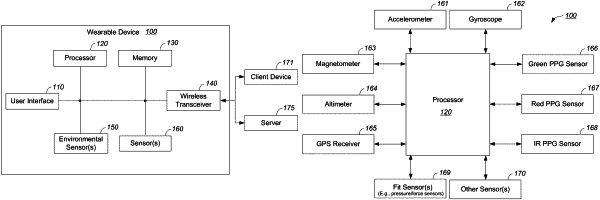| CPC A61B 5/6843 (2013.01) [A61B 5/01 (2013.01); A61B 5/02438 (2013.01); A61B 5/14552 (2013.01); A61B 5/332 (2021.01); A61B 5/681 (2013.01); A61B 5/684 (2013.01); A61B 5/7221 (2013.01)] | 14 Claims |

|
1. A computer-implemented method, comprising:
receiving first heart rate data of a user from a photoplethysmographic (PPG) sensor of a wearable device being worn by the user, the PPG sensor being positioned on a skin-side surface of the wearable device such that the PPG sensor is adjacent to skin of the user when being worn by the user;
receiving a first set of fit data from a plurality of fit sensors of the wearable device, the plurality of fit sensors being spaced apart from each other and from the PPG sensor on the wearable device, the first set of fit data being associated temporally with the first heart rate data, the first set of fit data including a contact force applied by the user at each of the plurality of fit sensors;
generating a first fit signature using the first set of fit data, the first fit signature being a first curve determined using curve fitting techniques on the first set of fit data, the first curve including a first estimated contact force applied by the user at the PPG sensor, the first curve being indicative of a fit of the wearable device on the user;
comparing the first fit signature to a predetermined range;
presenting a notification to the user via a display of the wearable device or an application on another device, when the first fit signature is outside the predetermined range, the notification prompting the user to adjust the position of the wearable device, wherein the notification is not presented via the display when the first fit signature is within the predetermined range;
designating the first heart rate data as a sub-optimal signal, responsive to determining that the first fit signature is outside the predetermined range;
receiving second heart rate data from the PPG sensor of the wearable device;
receiving a second set of fit data from the plurality of fit sensors, the second set of fit data associated temporally with the second heart rate data, the second set of fit data including a contact force applied by the user at each of the plurality of fit sensors;
generating a second fit signature based on the second set of fit data, the second fit signature being a second curve determined using curve fitting techniques on the second set of fit data, the second curve including a second estimated contact force applied by the user at the PPG sensor, the second curve being indicative of the fit of the wearable device on the user;
comparing the second fit signature to the predetermined range;
designating the second heart rate data as an acceptable signal when the second fit signature is within the predetermined range, wherein the second heart rate data is not designated as the acceptable signal when the second fit signature is outside of the predetermined range;
transmitting the second heart rate data having the acceptable signal to a memory; and
determining a heart rate of the user using the second heart rate data having the acceptable signal.
|